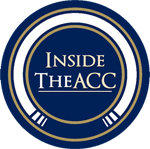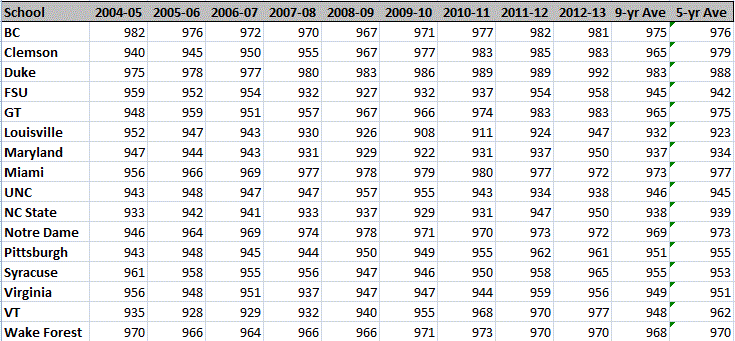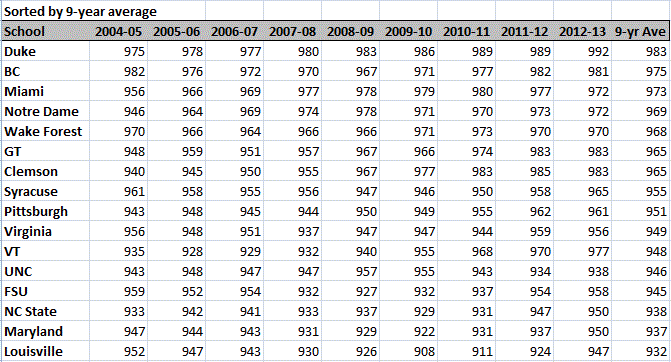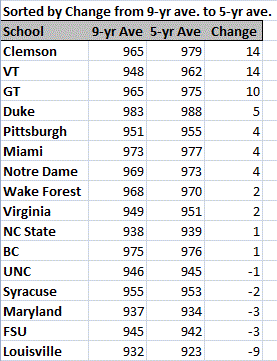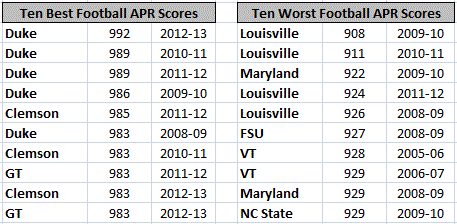Recently, the NCAA released its Academic Progress Rate (APR) report for the 2012-13 academic year. The NCAA now has nine years worth of APR data available on its web site, so we decided to break down the football APR data for the ACC, to see how its schools compare.
The APR was introduced almost a decade ago, and is, according to the NCAA’s web site, “a team-based metric that accounts for the eligibility and retention of each student-athlete, each term.” We won’t get into the details of how the APR works; we’re interested only in the data.
Some notes before we begin:
- All data are from the NCAA’s web site (see this link).
- The data presented include all current ACC members, regardless of length of membership.
- Departing ACC member Maryland is included in the data.
- Incoming member Louisville is included in the data.
- Notre Dame is included for comparison’s sake, even though they’re not an ACC member in football.
The raw data, sorted alphabetically by school
Click the image for a full-size view of the data.
Once you have the raw data, you can slice it and dice it many ways. We’ll take a look at:
- Sorted by 9-year average (the full life of the APR)
- Sorted by 5-year average (one full recruiting cycle)
- The change in 5-year average vs. 9-year average (improvement vs. degradation)
- The highest and lowest scores each year
- The ten best and ten worst scores in the 9-year history of the APR
Remember, this is football APR data only … and remember to click for a larger image.
APR scores sorted by 9-year average
Duke is far ahead of everyone else, and as we’ll see, the Blue Devils have been very consistent with their excellence.
Also worth noting: by swapping Louisville in for Maryland, the ACC is exchanging the two bottom teams on the list.
APR scores sorted by 5-year average
David Cutcliffe has been Duke’s head coach since 2008, and the Blue Devils are still #1 by a wide margin, but what really jumps out at you is that Clemson is #2 in the last five seasons. Note that Dabo Swinney took over as head coach in … you guessed it … 2008.
APR scores sorted by the change in 9-year average to 5-year average
Most schools in the ACC have improved their APR scores in recent years, bumping their 5-year average up over their 9-year average. The big movers are Clemson (not surprising, given the first two tables), Virginia Tech, and Georgia Tech (who has been coached by Paul Johnson since … wait for it … 2008).
Worth noting is that Louisville, already at the bottom of the league in the 9-year average, has gotten even worse, falling by 9 points, far and away the worst. Some of that happened under Charlie Strong’s watch; he was Louisville’s head coach from 2010-2013.
The best and the worst, year-by-year and overall
Here’s a look at which schools finished first and last year-by-year.
Duke is firmly in control. Louisville’s in a rut, but their five-year reign as worst was broken in the most recent year by UNC.
Here are the ACC’s ten best and ten worst football APR scores recorded in the 9-year history of the measurement.
Duke’s dominance and Clemson’s improvement can be clearly seen in the left-hand table, while Louisville’s dominance of the worst scores can be clearly seen in the right-hand table.
Note that of Louisville’s four entries in the ten-worst category, only two of those occurred under Charlie Strong. Maryland’s presence in the ten-worst table is not a surprise, and though Virginia Tech makes an appearance there, the Hokies have left that behind and are doing better now, as detailed above.
Our “takeaways,” as people like to say:
- There are no big surprises here. Most schools rank about where you would expect them to, based on academic reputation. You would expect Virginia and UNC to represent themselves a little better, however.
- Louisville is a bit of an academic stretch for the ACC, at least as measured by football APR scores, but this was known when the ACC invited the Cardinals.
- David Cutcliffe is an impressive football coach off the field, too.
- Everyone knows that Clemson has improved on the field under Dabo Swinney, but who knew they were improving this much off the field? Kudos to the Tigers coach.
Thanks for reading!

